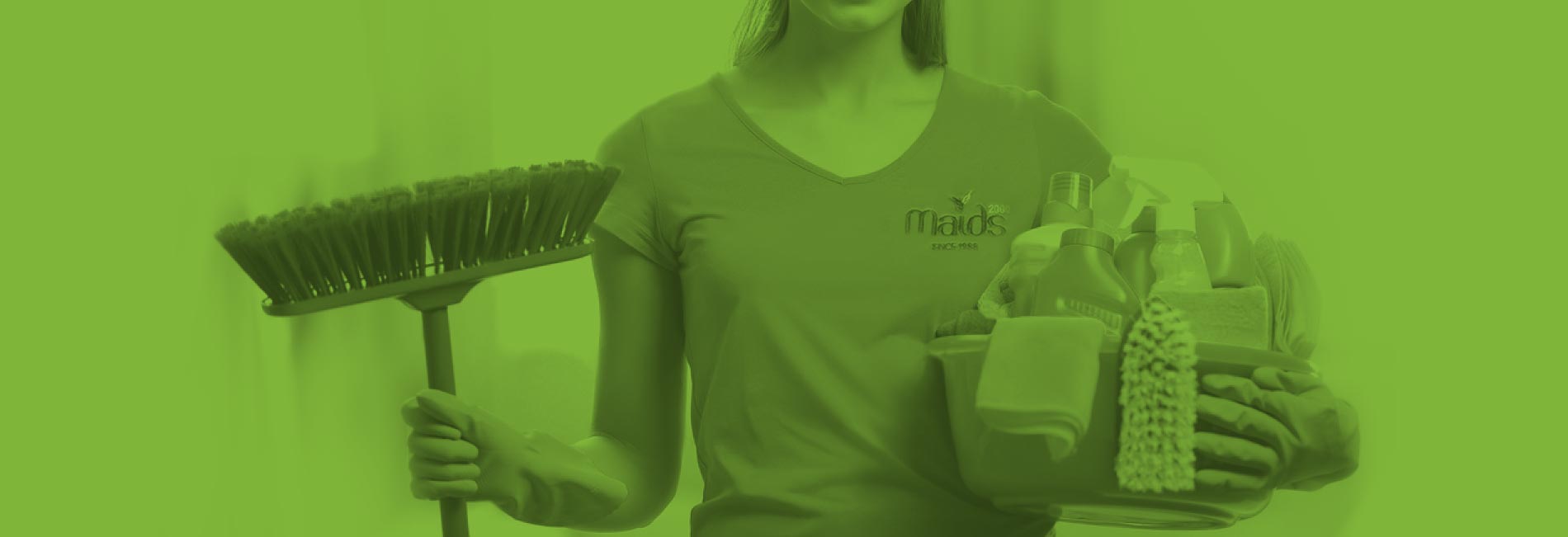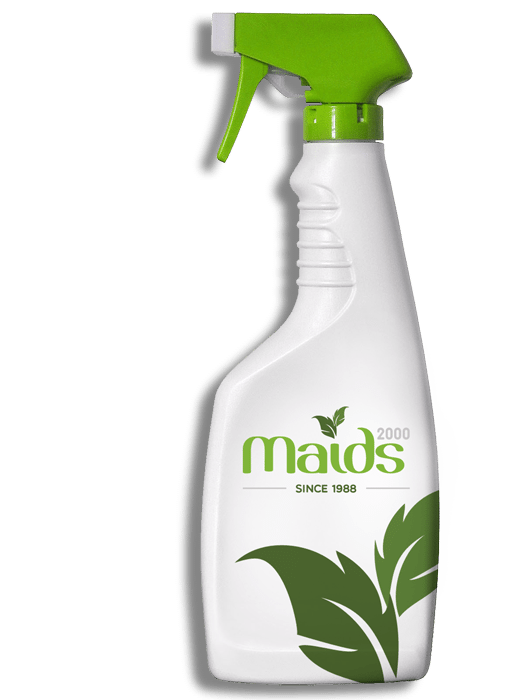“I am so Impressed.
My two children have severe allergies, specially where chemicals & cleaning products are concerned. I was somewhat hesitant when Maids2000 said their products were ‘Eco Clean’ but decided to give them a try anyway.
Boy was I ever pleased with the results! Not only was I blessed with a sparkling-clean home but my family came out of it without a sniffle. So wonderful.”

Take a Look at These Eco-Cleaning Tips You Can Do at Home.
Join the Maids2000 eco clean commitment to keeping our homes and environment safe by saying goodbye to the toxic fumes and residues left behind by harsh cleaning products with these eco clean tips. There are many inexpensive, environmentally friendly, family and pet safe products that we already keep in our homes that also make amazing homemade eco clean products. Some even grow in our own back yards! Lemons, white vinegar, baking soda, toothpaste and Ivory soap are among these items.
Lemons are the eco-clean fruit you should always have in your home. First juice the lemons for lemonade (why not get a refreshing drink out of the lemons, too?) then use the leftover halves for cleaning! Lemon juice is about 5 to 6 percent citric acid and has a pH level of between 2 and 3. This low pH acidity makes lemon juice a great ally in breaking down rust and mineral stains, but gentle enough to not dull finishes. There is generally sufficient juice left in used lemon halves to tackle small tasks, and it all comes with its own applicator (the rind itself). Plus, the oil in the peel is perfect for many cleaning applications.
Maids2000 TIPS:
Clean greasy messes…
Greasy pans, splattered stove tops and/or messy counters…Sprinkle salt (for abrasion) on a juiced lemon half and rub on the greasy areas, wipe up with a towel. (Be careful using lemon on marble counter tops or any other surface which may be sensitive to acid).
Clean your tea kettle or coffee pot…
For mineral deposit build up in your tea kettle, fill the kettle with water, add a handful of thin slices of lemon peel and bring to a boil. Turn off heat and let sit for an hour, drain, and rinse well. For coffee pots, add ice, salt and lemon rinds to the empty pot; swish and swirl for a minute or two, dump, and rinse.
Clean your microwave…
Add lemon rinds to a microwave-safe bowl filled halfway with water. Cook on high for 5 minutes, allowing the water to boil and the steam to condense on the walls and tops of the oven. Carefully remove the hot bowl and wipe away the mess with a towel.
Polish chrome…
Remove mineral deposits by rubbing with a squeezed lemon half, rinse, and lightly buff with a soft cloth.
Polish copper, brass or stainless steel…
Dip a juiced lemon half in salt and rub on the affected area. Let it stay on for 5 minutes. Then rinse in warm water and polish dry.
Keep insects out…
Many pests abhor the acid in lemon. You can chop of the peels and place them along thresholds, windowsills, and near any cracks or holes where ants or pests may be entering.
Make a scented humidifier…
If your home suffers from dry heat in the winter, you can put lemon peels in a pot of water and simmer on the lowest stove-top setting to humidify and scent the air.
Refresh cutting boards…
Because of lemon’s low pH, it has antibacterial properties that make is a good choice for refreshing cutting boards. After washing the cutting board with soap and water, give the surface a rub with a halved lemon, let sit for a few minutes, and rinse.
Deodorize the garbage disposal…
Use lemon peels to deodorize the garbage disposal (and make your kitchen smell awesome at the same time). It is a great way to finally dispose of spent lemon peels after you have used them for any of these applications.
Make a furniture polish…
1/2 teaspoon oil, such as olive (or jojoba, a liquid wax)
1/4 cup fresh lemon juice or vinegar
Mix the ingredients in a glass jar. Dab a soft rag into the solution and wipe onto wood surfaces. Cover the glass jar and store indefinitely.
Vinegar can disinfect, deodorize, and ‘de-gunkify’ just about everything from shower curtains to sofa cushions, not to mention it’s cheap, versatile, and doesn’t irritate most allergies. Vinegar’s magic ingredient is acetic acid, which comprises about 5 percent of the finished product and acts as a disinfectant and an odor neutralizer. Vinegar has been produced commercially for about 2,500 years, making it one of the oldest products in use by humans. There are many different types of vinegar out there, but white vinegar is the most useful and the most versatile by far.
Maids2000 TIPS:
Remove mold…
Put straight white vinegar into a spray bottle, spay on moldy area, and let set without rinsing. Smell will dissipate within a few hours.
Toilet Rim…
Use same full strength bottle to spray toilet rim. Let sit 5-15 minutes then scrub with a toilet scrubber or wipe with a rag.
Deodorize cutting board…
Use same bottle to spray cutting board. Spray before bed and let sit over night. No need to rinse.
Clean and deodorize the garbage disposal…
Mix equal parts vinegar and baking soda and putting it down the drain. After letting this fizzing mixture sit for a few minutes, flush out the drain with warm water for a clean and stink-free sink.
Clean and deodorize microwave…
Steam a bowl of equal parts vinegar and water in the microwave for 5 minutes. Wipe loosened, caked-on food with a clean towel.
Fruit fly trap…
Set out a small dish of white vinegar and some smashed fruit, cover with plastic wrap and poke small holes in it. The flies crawl into the trap, but can’t get out.
Decloud stemware…
If your stemware is cloudy from the dishwasher, wrap the glasses in paper towels soaked in vinegar, let them sit, and the cloudy deposits will rinse right off.
Clean grout…
There’s no need to use bleach on tile grouting when you can let vinegar soak on it and thenscrub with a toothbrush.
Clean CDs & DVDs…
Bring lightly scuffed or dirty DVDs back to life by wiping them down with some vinegar on a soft cloth.
Water marks on wood…
If you have water condensation marks on your wood, just rub the piece of furniture with equal parts vinegar and vegetable oil to remove them. Make sure to rub with the grain.
Cleaning mattress…
If a child has an “accident” on a mattress, clean it with a solution of vinegar and water. Afterwards, pour some baking soda onto the mattress, and brush or vacuum the residue once it’s dry.
Laundry…
Spraying vinegar onto deodorant-stained shirts before the wash can remove the discoloration. It’s also great for fighting mustard, tomato sauce, or ketchup stains. Adding a cupful ofvinegar to the rinse cycle of your washing machine freshens bright colors and gives you cleaner laundry, too. Acetic acid won’t harm fabrics, but dissolves the soap residue that can dull dark clothing. It also acts as a fabric softener, a static reducer, and a mildew-inhibitor.
Gum remover…
Vinegar will also loosen chewing gum stuck to car upholstery, rugs, and carpeting.
Windows…
Mix 1/4-1/2 teaspoon liquid detergent, 3 tablespoons vinegar and 2 cups water in a spray bottle, shake and use as you would a commercial brand. The soap in this recipe is important. It cuts the wax residue from the commercial brands you might have used in the past. Also, wiping down home and car windows with a three-to-one vinegar-water mixture keeps them frost-free in the wintertime.
Weed & slug killer…
Kill weeds and crabgrass growing in sidewalks and driveways by pouring vinegar onto them. A half-and-half solution of vinegar and water can even kill garden slugs if it’s sprayed directly onto them.
Extend the life of cut flowers
Add a few tablespoons of vinegar to the water in their vase, along with a teaspoon of sugar.
Pet care and protection…
Wipe out itchy ears with undiluted vinegar to keep dogs and cats from scratching at them.
Cats avoid vinegar, so to keep them from scratching furniture or sitting on certain areas, spray a vinegar solution onto the spot.
For outdoor areas, soak a sponge in vinegar and place it in the forbidden area to keep cats away. If kitty likes to mark his territory, spraying the area with vinegar can help eliminate the smell and deter recurrences.
Vinegar also gets rid of skunk odor. Soak the animal with a half-and-half vinegar and water solution, and then rinse with fresh water.
Baking soda, aka sodium bicarbonate, helps regulate pH—keeping a substance neither too acidic nor too alkaline. When baking soda comes in contact with either an acidic or an alkaline substance, its natural effect is to neutralize that pH. Beyond that, baking soda has the ability to retard further changes in the pH balance, known as buffering. This dual capability of neutralizing and buffering allows baking soda to do things such as neutralize acidic odors (like in the refrigerator) as well as maintain neutral pH (like in your laundry water, which helps boost your detergent’s power). It’s a simple reaction, but one that has far-reaching effects for a number of cleaning and deodorizing tasks.
Maids2000 TIPS:
Make a surface soft scrub…
For safe, effective cleaning of bathroom tubs, tile and sinks–even fiberglass and glossy tiles–sprinkle baking soda lightly on a clean damp sponge and scrub as usual. Rinse thoroughly and wipe dry. For extra cleaning power, make a paste with baking soda, coarse salt and liquid dish soap—let mixture sit then scour off.
Make and all-purpose spray cleaner…
Combine � teaspoon soda, dab of dish soap and 2 cups of hot tap water in a spray bottle. Shake until soda has dissolved. Apply and wipe off with a sponge or rag.
Hand wash dishes and pots & pans…
Add 2 heaping tablespoons baking soda (along with your regular dish detergent) to the dish water to help cut grease and foods left on dishes, pots and pans. For cooked-on foods, let them soak first, then use dry baking soda on a clean damp sponge or cloth as a scratchless scouring powder.
Freshen sponges…
Soak stale-smelling sponges in a strong baking soda solution to get rid of the mess (4 tablespoons of baking soda dissolved in 1 quart of warm water). For more thorough disinfecting, place in microwave for 15-30 seconds.
Clean microwave…
Baking soda on a clean damp sponge cleans gently inside and outside the microwave and never leaves a harsh chemical smell. Rinse well with water.
Polish silver flatware…
Use a baking soda paste made with 3 parts baking soda to 1 part water. Rub onto the silver with a clean cloth or sponge. Rinse thoroughly and dry for shining sterling and silver-plate serving pieces.
Clean coffee and tea Pots…
Remove coffee and tea stains and eliminate bitter off-tastes by washing mugs and coffee makers in a solution of 1/4 cup baking soda in 1 quart of warm water. For stubborn stains, try soaking overnight in the baking soda solution and detergent or scrubbing with baking soda on a clean damp sponge.
Oven cleaning…
Sprinkle water generously over the bottom of the oven, then cover the grime with enough baking soda that the surface is totally white. Sprinkle some more water over the top. Let the mixture set overnight. You can easily wipe up the grease the next morning because the grime will have loosened. When you have cleaned up the worst of the mess, dab a bit of liquid detergent or soap on a sponge, and wash the remaining residue from the oven. If oven doesn’t come clean, try again using more baking soda and/or water.
Clean floors…
Remove dirt and grime (without unwanted scratch marks) from no wax and tile floors using 1/2 cup baking soda in a bucket of warm water–mop and rinse clean for a sparkling floor. For scuff marks, use baking soda on a clean damp sponge, then rinse.
Clean furniture…
Clean and remove marks (even crayon) from painted furniture and walls by applying baking soda to a damp sponge and rubbing lightly. Wipe off with a clean, dry cloth.
Clean shower curtains…
Clean and deodorize your vinyl shower curtain by sprinkling baking soda directly on a clean damp sponge or brush. Scrub the shower curtain and rinse clean. Hang to dry.
Boost liquid laundry detergent…
Give your laundry a boost by adding � cup of baking soda to your laundry to make
liquid detergent work harder. A better balance of pH in the wash gets clothes cleaner, fresher, and brighter.
Gently clean baby clothes…
Baby skin requires the most gentle of cleansers, which are increasingly available, but odor and stain fighters are often harsh. For tough stains add 1/2 cup of baking soda to your liquid laundry detergent, or a 1/2 cup in the rinse cycle for deodorization.
Clean cloth diapers…
Dissolve � cup of baking soda in 2 quarts of water and soak diapers thoroughly.
Clean and freshen sports gear…
Use a baking soda solution (4 tablespoons Baking soda in 1 quart warm water) to clean and deodorize smelly sports equipment. Sprinkle baking soda into golf bags and gym bags to deodorize. Clean golf irons (without scratching them!) with a baking soda paste (3 parts Baking soda to 1 part water) and a brush. Rinse thoroughly.
Remove Oil and Grease Stains…
Use Baking soda to clean up light-duty oil and grease spills on your garage floor or in your driveway. Sprinkle baking soda on the spot and scrub with a wet brush.
Clean Batteries…
Baking soda can be used to neutralize battery acid corrosion on cars, mowers, etc. because it’s a mild alkali. Be sure to disconnect the battery terminals before cleaning. Make a paste of 3 parts baking soda to 1 part water. Apply with a damp cloth to scrub corrosion from the battery terminal. After cleaning and re-connecting the terminals, wipe them with petroleum jelly to prevent future corrosion. Use caution careful when working around batteries–they contain a strong acid.
Car wash…
Use baking soda to clean your car lights, chrome, windows, tires, vinyl seats and floor mats without worrying about unwanted scratch marks. Use a baking soda solution of 1/4 cup baking soda in 1 quart of warm water. Apply with a sponge or soft cloth to remove road grime, tree sap, bugs, and tar. For stubborn stains use baking soda sprinkled on a damp sponge or soft brush.
Deodorize refrigerator…
Place an open box in the back of the fridge to neutralize odors.
Deodorize cutting board…
Sprinkle the cutting board with baking soda, scrub, rinse.
Deodorize trashcans…
Sprinkle baking soda on the bottom of your trashcan to keep stinky trash smells at bay.
Deodorize recyclables…
Sprinkle baking soda on top as you add to the container. Clean recyclable container periodically by sprinkling baking soda on a damp sponge, wiping and rinsing.
Deodorize drains and garbage disposal…
To deodorize your sink and tub drains, and keep lingering odors from resurfacing, pour 1/2 cup of baking soda down the drain while running warm tap water–it will neutralize both acid and basic odors for a fresh drain. (This is a good way to dispose of baking soda that is being retired from your refrigerator.)
Dishwasher…
Use Baking soda to deodorize before you run the dishwasher and then as a gentle cleanser in the wash cycle.
Deodorize lunch boxes…
Between uses, place a spill-proof box of baking soda in lunch boxes to absorb lingering odors.
Remove odor from carpets…
Liberally sprinkle baking soda on carpet. Leave overnight or as long as possible (the longer, the better). Sweep up the larger amounts of baking soda and vacuum up the rest. (Note that your vacuum cleaner bag will get full and heavy) This also deodorizes your vacuum cleaner.
Freshen closets…
Place a box on the shelf to keep the closet smelling fresh.
Deodorizing cars…
Sprinkle baking soda directly on fabric seats and carpets. Wait at least 15 minutes (longer for strong odors). Then vacuum.
Deodorize cat box…
Cover the bottom of the pan with baking soda. Fill as usual with litter. To freshen between changes, sprinkle baking soda on top of the litter after scooping out waste.
Deodorize pet bedding…
Eliminate odors from your pets bedding by sprinkling liberally with baking soda. Wait 15 minutes (or longer for stronger odors). Then vacuum up.
Deodorize sneakers…
Keep odors from spreading in smelly sneakers by shaking baking soda into them when not in use. Shake out before wearing.
Freshen linens and other laundry…
Add 1/2 cup of baking soda to the rinse cycle for fresher sheets and towels.
Freshen stuffed animals…
Keep favorite cuddly toys fresh with a dry shower of baking soda. Sprinkle baking soda on and let it sit for 15 minutes before brushing off.
Camping cure-all…
Baking soda is a must-have for your next camping trip. It’s a dish washer, pot scrubber, hand cleanser, deodorant, tooth paste and fire extinguisher.
Extinguish fires…
Baking soda can help in the initial handling of minor grease or electrical kitchen fires, because when baking soda is heated, it gives off carbon dioxide, which helps to smother the flames. For small cooking fires (frying pans, broilers, ovens, grills), turn off the gas or electricity only if you can safely do so. Stand back and throw handfuls of baking soda at the base of the flame to help put out the fire. Call the Fire Department just to be safe.
Septic care…
Regular use of baking soda in your drains can help keep your septic system flowing freely. Flushing 1 cup of baking soda per week will help maintain a favorable pH in your septic tank.
There are a number of forms of salt produced for consumption (and by default, housekeeping!): unrefined salt (such as sea salt), refined salt (table salt), and iodized salt. Kosher salt is sodium chloride processed to have flat crystals.
Maids2000 TIPS:
General cleaning…
Salt works as an effective yet gentle scouring agent. Salt also serves as a catalyst for other ingredients, such as vinegar, to boost cleaning and deodorizing action. For a basic soft scrub, make a paste with lots of salt, baking soda and dish soap and use on appliances, enamel, porcelain, etc.
Save the bottom of your oven…
If a pie or casserole bubbles over in the oven, put a handful of salt on top of the spill. It won’t smoke and smell and it will bake into a crust that makes the baked-on mess much easier to clean when it has cooled.
Clean sink drains…
Pour salt mixed with hot water down the kitchen sink regularly to deodorize and keep grease from building up.
Remove water rings…
Gently rub a thin paste of salt and vegetable oil on the white marks caused by beverage glasses and hot dishes, on wooden tables.
Clean greasy pans…
Cast-iron skillets can be cleaned with a good sprinkling of salt and paper towels.
Clean stained cups…
Mix salt with a dab of dish soap to make a soft scrub for stubborn coffee and tea stains.
Clean refrigerators…
A mixture of salt and soda water can be used to wipe out and deodorize the inside of your refrigerator.
Clean brass or copper…
Mix equal parts of salt, flour and vinegar to make a paste, and rub the paste on the metal. After letting it sit for an hour, clean with a soft cloth or brush and buff with a dry cloth.
Clean rust…
Mix salt and cream of tartar with just enough water to make a paste. Rub on rust, let dry, brush off and buff with a dry, soft cloth. You can also use the same method with a mix of salt and lemon.
Clean a glass coffee pot…
Every diner waitress’ favorite tip: add salt and ice cubes to a coffee pot, swirl around vigorously, and rinse. The salt scours the bottom, and the ice helps to agitate it more for a better scrub.










